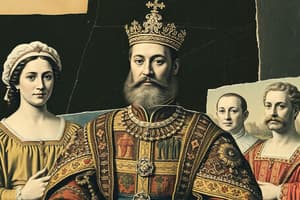Podcast
Questions and Answers
Match the following historical figures with their roles or titles:
Match the following historical figures with their roles or titles:
Charles V = Holy Roman Emperor Phillip II = King of Spain Henry IV = French King of Navarre Louis XIV = Sun King of France
Match the following terms with their descriptions:
Match the following terms with their descriptions:
Absolute Monarchy = Rule by a single person with no legal restrictions Huguenots = French Protestants in the 16th-17th centuries Edict of Nantes = Granted religious freedom to Protestants in France Intendant = Royal officials in France overseeing local administration
Match the following events with their significance:
Match the following events with their significance:
Edict of Nantes = Promoted religious tolerance Spanish Armada = Failed military campaign against England Thirty Years' War = Series of conflicts in Europe involving multiple states Frondes = Civil wars in France against Mazarin's government
Match the following leaders with their key policies:
Match the following leaders with their key policies:
Match the following concepts with their characteristics:
Match the following concepts with their characteristics:
What characteristic is primarily associated with Louis XIV's rule in France?
What characteristic is primarily associated with Louis XIV's rule in France?
Which of the following leaders is known for the policy of westernization in Russia?
Which of the following leaders is known for the policy of westernization in Russia?
What was the primary purpose of the Edict of Nantes issued by Henry IV?
What was the primary purpose of the Edict of Nantes issued by Henry IV?
Which term best describes the political structure established in England after the English Civil War?
Which term best describes the political structure established in England after the English Civil War?
What was a significant outcome of the Peace of Westphalia?
What was a significant outcome of the Peace of Westphalia?
Flashcards are hidden until you start studying
Study Notes
Hapsburg Dynasty
- Charles V ruled the Holy Roman Empire and Spain, known for his extensive territories and challenges, including the Protestant Reformation.
- Philip II succeeded Charles V, he was a staunch Catholic and faced numerous conflicts, including the Spanish Armada against England.
Absolute Monarchy
- Absolute monarchy is a form of government where the monarch holds supreme authority, often justified by the divine right of kings.
- Louis XIV embodies absolute monarchy, famously declaring, "L'état, c'est moi" (I am the state).
French Religious Conflicts
- Huguenots were French Protestants, often facing persecution during the 16th and 17th centuries.
- Henry IV issued the Edict of Nantes in 1598, granting religious tolerance to Huguenots.
Key French Figures
- Cardinal Richelieu was Louis XIII's chief minister, centralizing power and weakening the nobility to strengthen the monarchy.
- Intendants were royal officials in France who enforced the king's policies, reducing the power of local nobles.
- Jean Baptiste Colbert served as finance minister under Louis XIV, implementing mercantilism to boost the economy.
Versailles and Court Life
- Versailles was the grand palace built by Louis XIV, symbolizing absolute monarchy and used to control the French nobility.
- Levee was the morning ritual involving the king, showcasing royal authority and the importance of court etiquette.
International Relations
- The concept of the balance of power seeks to maintain equality among nations to prevent any single state from dominating.
- The Peace of Westphalia in 1648 ended the Thirty Years' War and established principles of state sovereignty and territorial integrity in Europe.
Austrian Monarchy
- Maria Theresa was the first female ruler of the Habsburg dominions, her reign marked by reforms and military challenges.
- The War of Austrian Succession (1740-1748) involved conflicts over Maria Theresa's succession, impacting European power dynamics.
Prussian Leadership
- Frederick William I transformed Prussia into a powerful state through military organization and centralization.
- Frederick II, also known as Frederick the Great, expanded Prussia's territory and implemented enlightened reforms.
Russian Expansion and Reform
- Peter the Great focused on westernization, modernizing the Russian army and government structures to align with European powers.
- The term boyar refers to the noble class in Russia, often opposing reforms initiated by monarchs like Peter the Great.
- Autocratic rule characterized Peter's leadership style, focusing on centralized control and modernization efforts.
St. Petersburg
- St. Petersburg was founded by Peter the Great as a "window to the west," symbolizing his commitment to modernization and westernization.
Catherine the Great
- Catherine the Great expanded Russian territory and continued westernization efforts, influencing European politics through enlightened policies.
- The partitions of Poland (1772, 1793, 1795) involved the division of Polish territory among Russia, Prussia, and Austria, significantly reducing Poland's sovereignty.
British Monarchy and Government
- James I, the first Stuart king, faced conflicts with Parliament, leading to tensions over governance.
- Dissenters were nonconformists who opposed the practices of the Church of England, significantly impacting religious landscape.
- Puritans sought to "purify" the Church and faced persecution, influencing the English Civil War.
English Civil War
- Charles I's conflict with Parliament led to the English Civil War, culminating in his execution.
- Oliver Cromwell emerged as a leader during the Civil War, establishing a republican form of government.
English Constitutional Developments
- The English Bill of Rights (1689) laid the foundation for a constitutional monarchy, limiting the power of the crown.
- Limited monarchy is characterized by the monarch exercising power in conjunction with an elected body, unlike absolute rule.
- A constitutional government operates under a system of laws that restrict governmental powers.
- The cabinet system evolved, leading to the establishment of the prime minister role, integral in managing government affairs.
- Oligarchy describes a government controlled by a small group, often elite or wealthy individuals, limiting broader participation.
Studying That Suits You
Use AI to generate personalized quizzes and flashcards to suit your learning preferences.




